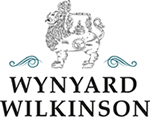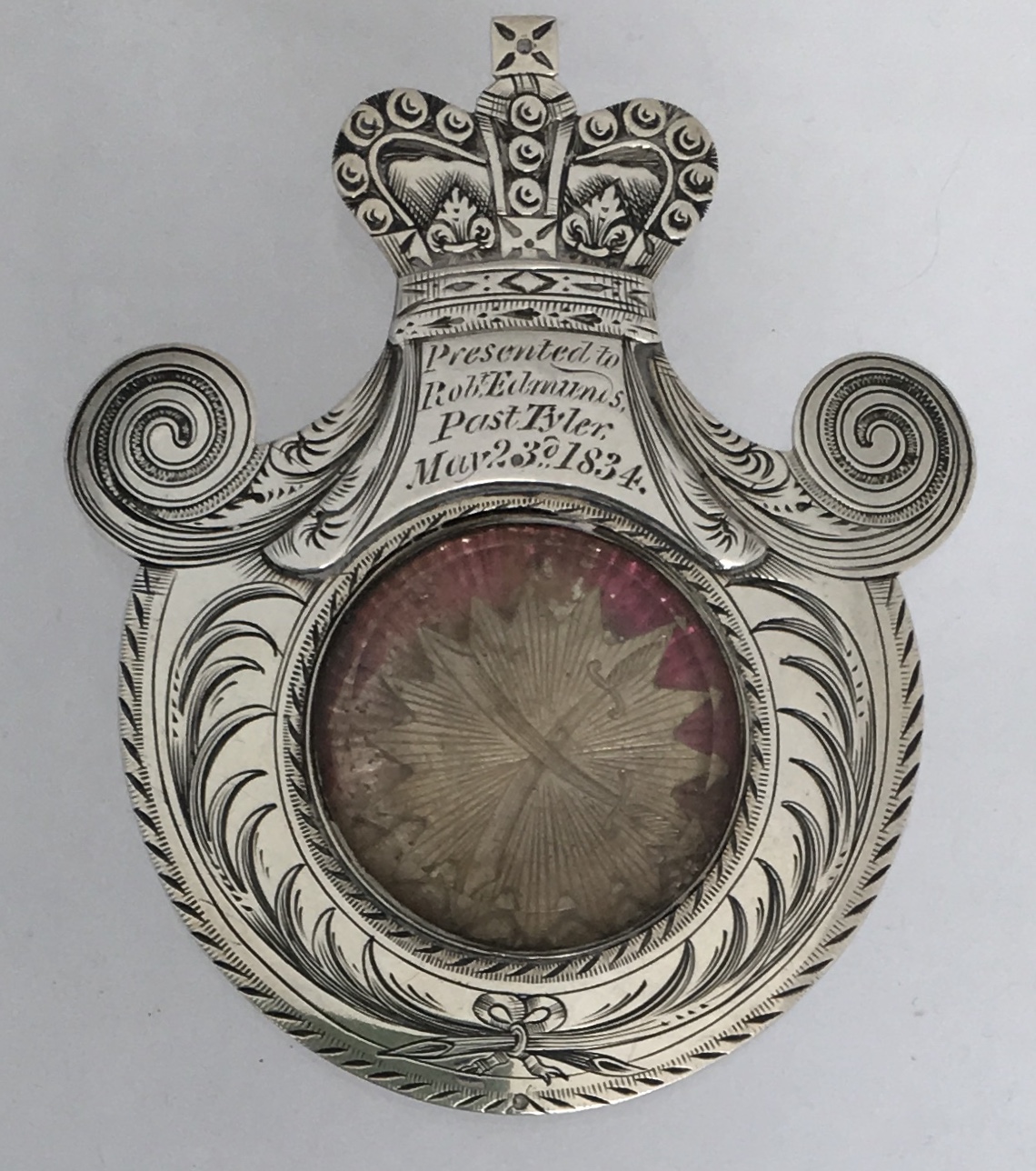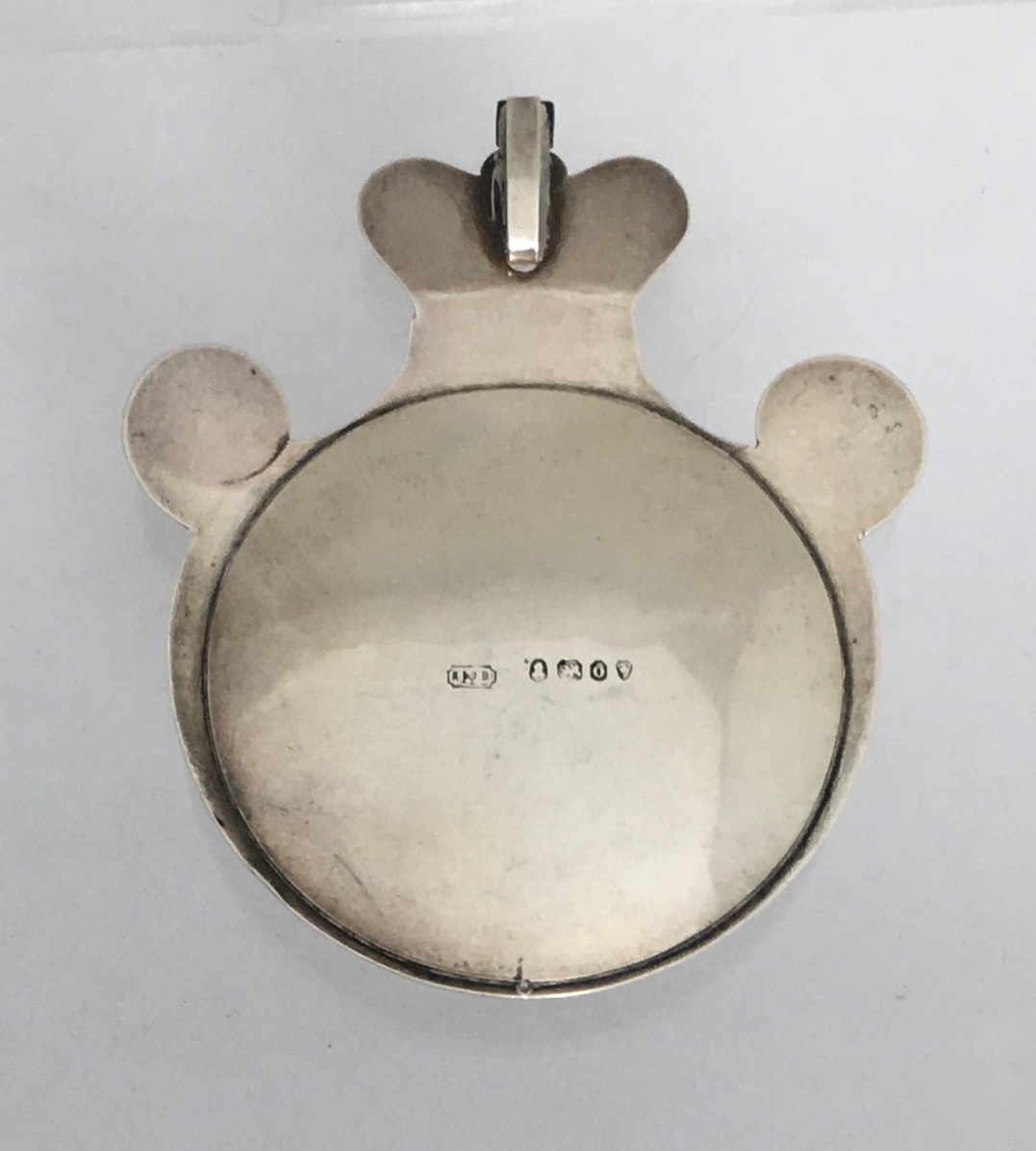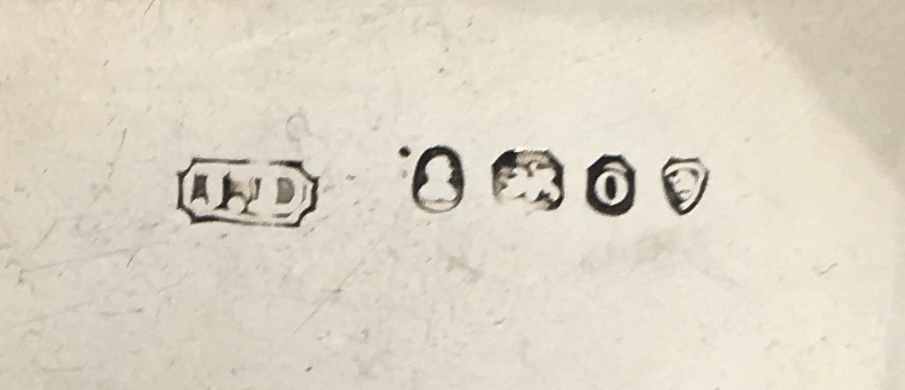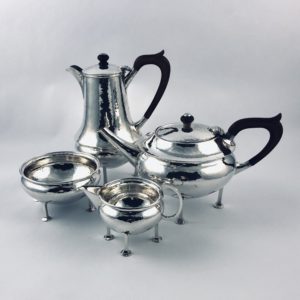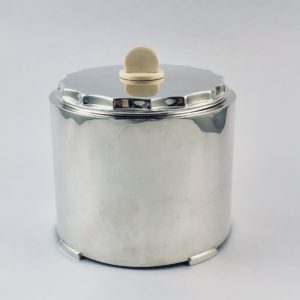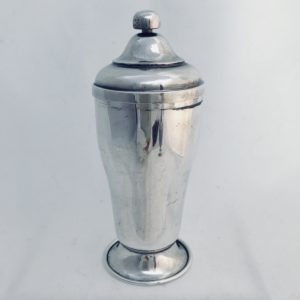Description
An attractive and unusual silver Masonic jewel of circular shape surmounted by a royal crown and scrolled mantling. The main body of the jewel is cut from sheet silver and hand engraved, with feathered edging and a palm wreath surrounding a central, circular cut-out framing a flattened glass dome. Covered by the dome is a 16-pointed star, also cut from sheet, engraved with radiating lines and two crossed scimitars, and set against a mauve pink foil backing. The badge has a slightly domed, circular backing sheet on the rear face. At the top of the jewel a silver hanger, enabling suspension from a ribbon, is attached to the rear of the crown.
As a result of the depth of decorative engraving on the jewel body, a split follows the curve on one scroll (see picture of jewel reverse, where this shows clearly on the left scroll).
Inscription:
On a separate piece of cut sheet, laid over the upper part of the badge and forming part of the mantling and the lower rim of the crown, is an engraved inscription: Presented to Robt Edmunds, Past Tyler. May 23d1834.
Maker’s Marks:
Maker’s mark of ‘J.D’ in a rectangular punch with concave corners for Joseph Dallinger, a silversmith working in Ipswich from 1824, then Norwich from 1828 (see more below); William IV duty mark; Lion Passant (Sterling); lower case ‘o’ (1829-30); Leopard’s head (London assay office).
Dimensions & Weight:
Height: 8.3 cm/ 3 ¼ ins; Width: 7 cm / 2 ¾ ins; Weight (net): 38 gms.
Masonic Jewels
Masonic jewels can be classified[1] in several different ways. Leaving aside commemorative or specially granted jewels, a fundamental distinction is between Lodge jewels, which belong to the Lodges concerned, and personal jewels, the property of individual members. The other main distinction is between collar jewels, worn suspended from a collar, and breast jewels, worn in the manner of a medal. Jewels may also be classified by the method of manufacture as pierced, cast or plate. This item is a personal, collar jewel.
[1]Timothy Kent, Thomas Harper, Masonic jeweller and the jewels of his period, in Silver Studies, the Journal of the Silver Society, No. 19, 2005, p. 14.
The Masonic Tyler
Tyler (or Tiler) is the name of the office of outer guard of a Masonic Lodge. Masonic lodges may meet in rooms in taverns and other public meeting places, and all Lodges appoint a Tyler to guard the door from the outside against ineligible masons or malicious or curious people, to check the eligibility of latecomers, and to ensure that candidates for ceremonies in the Lodge are properly prepared. Although a junior Officer of the Lodge and often a highly experienced Past Master, he may often be considered akin to a sergeant: in some cases the Tyler may not be an unpaid member of the lodge, but a mason from another lodge employed for the purpose. Other duties often involve preparing the room for meetings, supplying regalia and equipment, serving as bar steward or acting as permanent, and sometimes resident, caretaker of the furniture and premises.
Duties of the post
In some Jurisdictions the Tyler is appointed by the Worshipful Master, while in others he is elected by the members of the Lodge. He is charged with examining the Masonic credentials of anyone wishing to enter the Lodge, keeping unqualified persons from infiltrating Masonic meetings, and admitting only those qualified to attend the current business.
In most jurisdictions, the Tyler is required to be outside the Lodge door for large portions of the meeting, although usually in a position to overhear the proceedings. The position has often been given to a deserving Mason who has fallen on hard times or to a senior Lodge member who can help and advise those kept waiting outside.
William Hogarth’s famous print of Night shows a drunken Mason being helped home by the Tyler, from one of the four original Lodges in 1717 at the Rummer & Grapes tavern.
In some jurisdictions, the Worshipful Master has the authority to permit or direct the Tyler to “tyle from within” during the non-ritualistic portions of a meeting. If tyling from within, the Tyler must first secure the outer doors of the Tyler’s anteroom. He would then leave the inner door open between the lodge room and the Tyler’s anteroom, and sit at the seat closest to the door, still holding his drawn sword. Tyling from within enables the Tyler to participate in the business portions of the meeting, voice his opinions, volunteer for committees, deliver reports, and receive instruction if any be given. In other jurisdictions, such as the United Grand Lodge of England, the Tyler is always expected to be outside the closed door of the lodge; on the rare occasions when the Tyler enters the lodge room, another lodge member (typically the Inner Guard or, in the USA, the Junior Deacon) goes outside to take temporary responsibility for guarding the door.
Origins of the term
The origins of the term are uncertain and a number of hypotheses have been presented over time. Masonic lodges originally met in inns or taverns, and Tyler is an Old English word for the keeper of an inn door. Alternatively, the name may simply come from the occupation of tyler, a person who lays roof and floor tiles.
The recipient – Robert Edmunds
There is a record of a ‘Robert Edmunds’ in Norfolk from June 1785 to November 1866, a wheelwright, but it can not be established if he was a member of a masonic lodge.
The silversmith – Joseph Dallinger
Born, Ipswich ca. 1787; died, Norwich 8 Aug 1871. The 1861 Census records him and his son, Joseph Alexander Dallinger, and he is described as an engraver employing two men and a boy. He worked initially in Ipswich, registering a mark at Goldsmiths’ Hall as a plateworker on 11 May 1824, until handing that business over to his nephew William Henry Dallinger and moving to 12 Davey Place, Norwich from where he registers his second mark at Goldsmiths’ Hall on 2 May 1828. He is later recorded as engraver, lithographer and copperplate printer.
